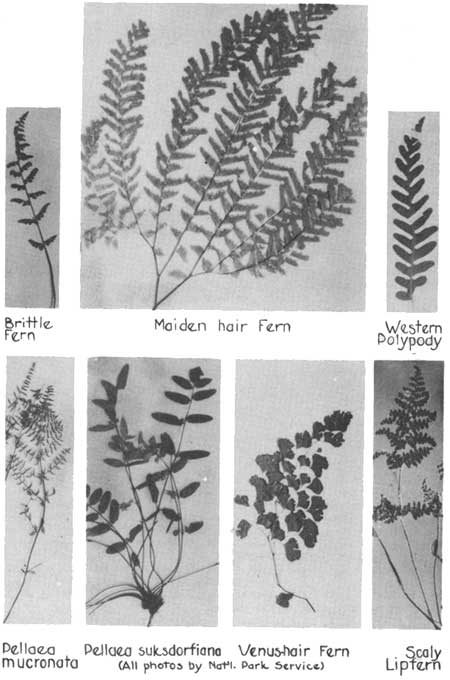|
ZION
Plants of Zion National Park |

|
Zion-Bryce Museum Bulletin
Number 1
PLANTS OF ZION NATIONAL PARK
Families of Plants
FERN FAMILY (POLYPODIACEAE)
Although ferns are not common in this region, owing to the semi-desert climate, they are often seen by Zion visitors because nearly all the trails lead through cool moist canyons where growing conditions are ideal. Ferns belong to a very ancient group of plants that reproduce by spores rather than by seeds. Often, when a fern is shaken or rubbed on the lower surface the spores appear as a yellowish dust coming from little "fruit dots" or sori.
ROCKY MOUNTAIN WOODSIA, Woodsia scopulina. A small delicate fern having a resemblance to the brittle fern (see photo). It has been found in rock crevices in Hidden and Echo Canyons, and may occur in other similar habitats.
BULBLET FERN, Filix bulbifera. This small fern is found in Hidden Canyon, and will probably be found in other canyons by careful observers. It closely resembles the brittle fern, but has a straw-colored stipe, or "stem", in contrast to the dark brown or black stipe of the brittle fern.
BRITTLE FERN, Filix fragilis. (Plate I). This fern, easily recognized by the photograph, is common in all the cool canyons, growing on moist slopes and ledges, and in crevices.
WESTERN POLYPODY, Polypodium hesperium. (Plate I). In the coolest canyons this, the plainest appearing one of our small ferns, is occasionally found growing in the same moist places as the bulblet fern. Visitors from the Pacific Northwest will recognize it as a relative of the licorice fern. It is most apt to be seen in Hidden Canyon and some of the small canyons around Mount Majestic on the West Rim Trail, but is not common.
WOOD FERN, or MALE FERN, Dryopteris filix-mas. This is by far the largest fern that will be found in the cool, moist canyons, its rank upright fronds reaching a length of from 1 to 4 feet. It has heavy tapering fronds ascending from a compact crown and is not likely to be confused with any other fern in the park. It is common in nearly every cool canyon above 5500 feet.
BRAKEN, Pteridium aquilinum pubescens. The wood fern and the braken are the only large heavy ferns in the park, but this one is easily distinguished by the fact that it grows on fairly open slopes or flats having deep soil, rather than in canyons. Also, it does not grow in clumps, but each frond by itself, erect on a heavy woody "stem" (stipe). It has a very coarse appearance, and grows from 1 to 3 feet high.
MAIDENHAIR FERN, Adiantun pedatum aleuticum. (Plate I) Perhaps the most beautiful and best known of our ferns. Found in nearly all the cool canyons of Zion, but much less common than the following species.

PLATE I
VENUS HAIR FERN, Adiantum capillus-veneris. (Plate I). Very common in all cool moist places in the park, especially in the hanging gardens at Weeping Rock and The Narrows, where it grows profusely on wet cliffs.
SCALY LIPFERN, Cheilanthes covillei. (Plate I). An odd little fern that grows on dry rocks, in crevices, but is nowhere common. In dry weather its fronds curl up into little round balls with the scaly side exposed.
SUKSDORF CLIFFBRAKE, Pellaea suksdorfiana. (Plate I) All of the cliffbrakes are small dry-rock forms, and all are rather rare here. This species has been recorded only from the foot of the West Rim Trail and Temple of Sinawava, Zion Canyon. Pellaea mucronata has been found in dry rocky places near the base of Angel's Landing; and a very similar form with longer leaflets. Pellaea longimucronata, has been collected in dry talus near Emerald Pool.
HORSETAIL FAMILY (EQUISETACEAE)
Horsetails, or scouring rushes, are of a very old plant family which was at its height during the Coal Age, when some species attained the size of trees. The name scouring rush is given because the hollow, jointed stems contain so much silica as to be almost like sandpaper. Three kinds are recorded from the moist swampy places in Zion Park: Equisetum arvense, the commonest form; Equisetum laevigatum, less common and much larger, (1 to 3 feet high); and Equisetum kansanum.
SELAGINELLA FAMILY (SELAGINELLACEAE)
This family of moss-like plants is here represented only by the LITTLE CLUB MOSS, Selaginella mutica, which forms dense mats in Hidden Canyon and will probably be found on other shady cliffs. The leaves and branches of this low creeping plant resemble in miniature the foliage of the Big Tree (Sequoia gigantea).